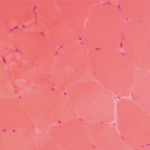
courtesy ACR Daily News
CHICAGO—At Hot Topics in Myositis, a session at the 2018 ACR/ARHP Annual Meeting, three experts discussed new classification criteria for idiopathic inflammatory myopathies (IIM) and offered practical primers on overlap myositis conditions and inclusion body myositis (IBM).
New Myositis Classification Criteria
After a 10-year development process, the new EULAR/ACR Classification Criteria for Adult and Juvenile Idiopathic Inflammatory Myopathies and Their Major Subgroups was published in 2017.1 These criteria reflect updated knowledge of the myositis disease spectrum and included 976 myositis cases and 624 comparators contributed by 47 rheumatology, dermatology, neurology and pediatric clinics worldwide, said Ingrid E. Lundberg, MD, PhD, a professor in the Division of Rheumatology at Karolinska Institute, Karolinska University Hospital, Sweden.
“Inflammatory myopathies are a heterogeneous group of diseases, now with several subdiagnoses that have been identified. There are a number of new autoantibodies that have been identified. It’s recognized that extramuscular organ involvement is frequently seen in patients,” said Dr. Lundberg.
The new criteria score variables in a case to determine the probability a patient has one of several IIM conditions. Variables include age of first symptom onset; clinical muscle symptoms, such as weakness; skin variables, such as heliotrope rash or Gottron’s papules; other clinical variables, such as dysphagia or esophageal dysmotility; laboratory variables, such as elevated serum creatine kinase (CK) and other muscle enzymes, as well as positivity for autoantibodies, such as anti-Jo-1; and muscle biopsy results. Each variable is weighted differently on the basis of whether the patient does or does not have muscle biopsy data. The criteria development committee recommended having 55% probability as a lower limit for classification, or a score of 5.5 without a muscle biopsy and 6.7 with biopsy. A patient with 90% probability is classified as a definite myositis case.
‘A normal CK does not exclude myositis.’ —Ingrid E. Lundberg, MD, PhD
A flow chart helps users subclassify patients with a confirmed IIM: They first consider the patient’s age of disease onset; patients under 18 years old are subclassified as having juvenile dermatomyositis (JDM) if they have a skin rash and juvenile myositis if they do not have a rash. Patients over 18 years old with a skin rash and muscle weakness are classified as having dermatomyositis (DM), and those without muscle weakness as having amyopathic DM.
Patients over 18 years old without the typical skin rash but with such clinical features as finger flexor weakness or rimmed vacuoles are classified with inclusion-body myositis, “whereas patients without these features end up in the group with polymyositis [PM],” said Dr. Lundberg. A free, online criteria calculator is available.

